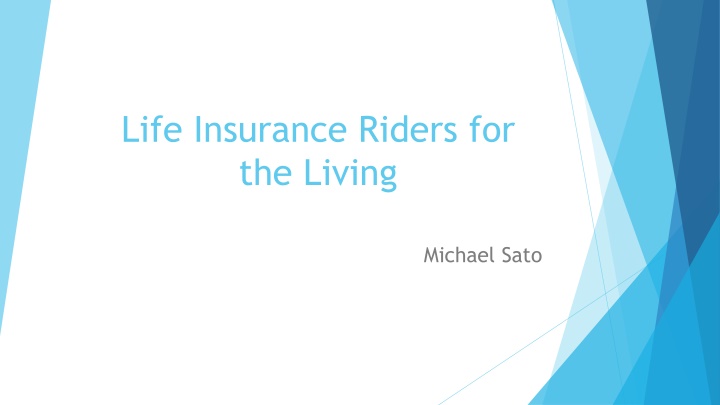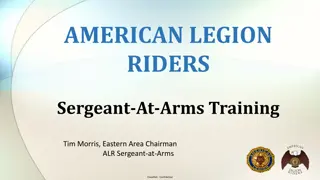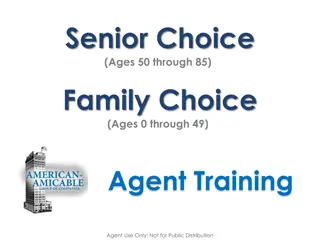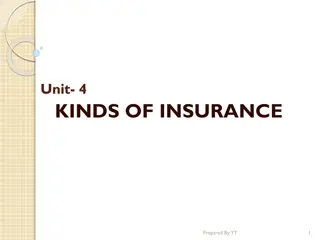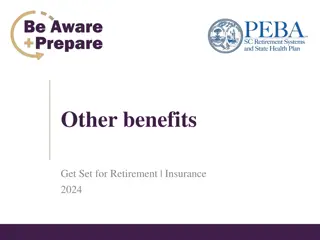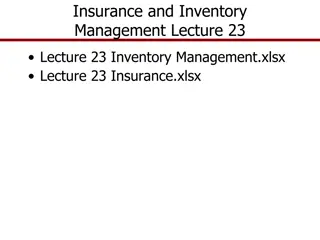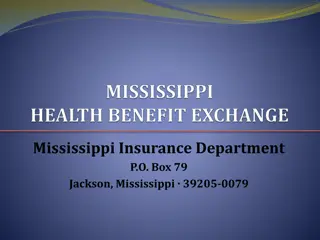Life Insurance Riders for the Living: Agenda and Best Practices
Explore the world of life insurance riders for living benefits, including Long-Term Care (LTC), Chronic Illness, and Critical Illness riders. Dive into recommended practices, rider risks, and consumer protections. Understand the various types of riders available and how they can benefit policyholders. Learn about upfront charges, underwriting, benefit acceleration, and more. Discover the nuances between different types of riders and how they impact the death benefit. Enhance your knowledge to better serve clients in their insurance needs.
Download Presentation

Please find below an Image/Link to download the presentation.
The content on the website is provided AS IS for your information and personal use only. It may not be sold, licensed, or shared on other websites without obtaining consent from the author.If you encounter any issues during the download, it is possible that the publisher has removed the file from their server.
You are allowed to download the files provided on this website for personal or commercial use, subject to the condition that they are used lawfully. All files are the property of their respective owners.
The content on the website is provided AS IS for your information and personal use only. It may not be sold, licensed, or shared on other websites without obtaining consent from the author.
E N D
Presentation Transcript
Life Insurance Riders for the Living Michael Sato
Agenda LTC Riders Chronic Illness Riders Critical Illness Riders Rider Risks Recommended LTC, Chronic, and Critical Illness Riders Best Practices
LTC Riders IRC Sec 7702B Can be described and marketed as Long-Term Care Need Health License and CE to sell (subject to state variations) Have upfront charges and the rider is underwritten Entire death benefit is eligible for acceleration Benefit payments reduce death benefit dollar for dollar Appear less competive on illustrations vs. riders with no upfront charges
LTC Riders Built-in Consumer Protections Unintentional Lapse Lapse protection while on claim Reinstatement Provision Extension of benefits Some offer residual DB to cover final expenses
Chronic Illness Riders If you don t know what type of CI rider you are selling, then how can your client know what they are buying? What happens when they go to make a claim and are crushed at the discovery that only a fraction of the death benefit can be accelerated?
Chronic Illness Riders Are you selling: Up-front charges: Chronic illness riders with upfront charges and known predictable benefits? Discount method: Chronic illness riders where the charge and benefit amount is unknown until claim? Lien method: Chronic illness riders where the chronic illness benefit amount is known, but the death benefit is unknown
Chronic Illness Riders with Upfront Charges IRC Sec 101(g) Prohibited from being described or marketed as long-term care Do not need Health License to sell Have upfront charges and the rider is underwritten Entire death benefit is eligible for acceleration Benefit payments reduce death benefit dollar for dollar Appear less competive on illustrations vs. riders with no upfront charges Typically, indemnity
Chronic Illness Riders with no Charge until Acceleration Most prevalent rider solution in the market IRC Sec 101(g) Automatically included up to certain age/table rating (No additional underwriting) Prohibited from being described or marketed as long-term care Do not need Health License to sell Since charge applied at acceleration, unable to accelerate entire death benefit Indemnity
Chronic Illness Riders with no Charge until Acceleration Discount method: Charge and benefit determined at claim. Amount eligible to be accelerated can vary by factors such as: age life expectancy (severity of condition) gender, future premiums, cash value, permanent or term product, and interest rate. Lien method: Benefit amount is known at issue, but the remainder death benefit is unknown. Here the cost (compounding lien) is deducted from the remainder death benefit paid to the beneficiary. Illustration advantage-No drag of monthly charge makes product appear more competitive.
Nationwide LTC Rider Cash indemnity (Informal Care) 2,3, or 4% acceleration of DB Can select less LTC than DB (10-100%) Ability to add after issue Residual DB of 10% Policy will not lapse if CV becomes insufficient to cover monthly deductions while on claim 90 calendar days elimination period Couples discount
Securian ADB for CI Agreement Indemnity (Informal Care) 2 or 4% acceleration of DB Can select less LTC than DB (10-100%) Temporary and permanent conditions Ability to add after issue Residual DB of 10% If policy accumulation value goes to 0 on claim, all policy and agreement charges are waived 90 calendar days elimination period
John Hancock Critical Illness Benefit Rider CI benefit separate from life insurance, so acceleration does not reduce DB 10 or 25% of DB up to $250K
Assurity Critical Illness Benefit Rider CI benefit separate from life insurance, so acceleration does not reduce DB $20-100K benefit on term policies (Cannot exceed base DB) $5-75K benefit on WL policies (Cannot exceed base DB) Can claim multiple times
Best Practices Learn the riders you are selling Take care in choosing which rider type is best suited for your client MANAGE EXPECTATIONS ON HOW THE RIDER PAYS OUT. All riders are good. The problem is are we adequately disclosing how they work? Address in policy reviews Call Oxy to help design policies that meet your client s needs and expectations
Thank you! Michael Sato msato@askoxy.com (808) 527-8869
